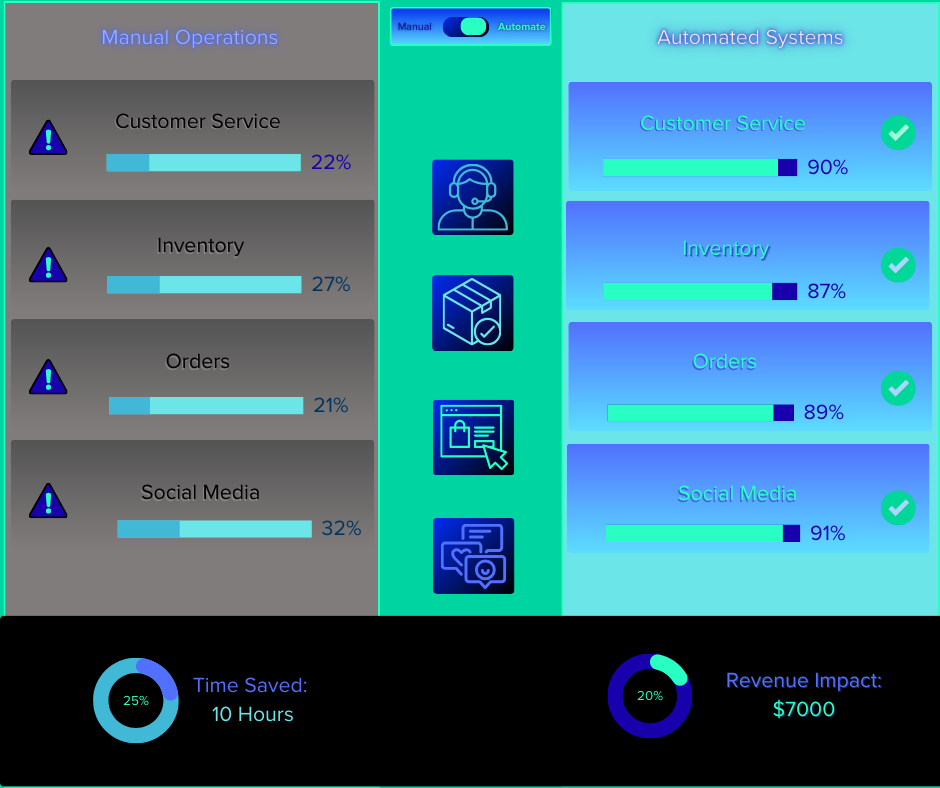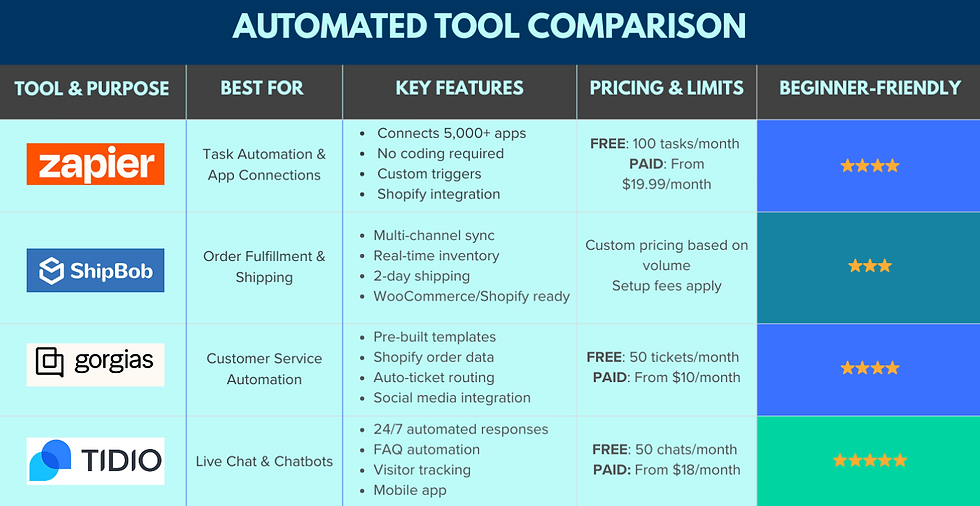From 60-Hour Weeks to Freedom: Automate Your E-Commerce Business
- Shawn Ferguson

- Aug 20, 2025
- 4 min read
Starting an e-commerce business seemed simple. You found winning products that were sure to make money. But then reality hit.
Suddenly, you became a web designer, marketer, copywriter, supply chain manager, and customer service rep all at once. You started growing your business, but then problems began.

The platform froze your money. Your product launches didn't match your effort.
You're spending 6 hours daily on tasks that machines could handle.
It's time to stop the madness.
If you're new to e-commerce or ready to scale, you might feel overwhelmed managing orders, emails, and social media right now. The good news? Automation can simplify these tasks and give you back the time you need to plan your next big win.
The Hidden Cost of Manual Work

When you spend hours answering the same customer questions and fixing manual data entry errors, you're not just losing time. You're losing money.
Here's the breakdown: Manual work can drop your yearly revenue by 20%. Meanwhile, 60% of e-commerce businesses are already using automation to cut costs and save time while growing faster. They're gaining a competitive edge while you're stuck in the weeds.
But automation can save you 40-60 hours each month. Think about it: If you value your time
at $50 per hour, saving 10 hours weekly equals $26,000 in reclaimed value annually. That's money you can reinvest in growth or simply pocket.
Time You Could Save Right Now
Marketing: Save 6+ hours per week instead of losing an hour daily managing social media. For example, use a tool like Buffer to schedule social media posts in 30 minutes a week instead of posting daily.
Project management: Get back 20% of your day with automated workflows that handle routine tasks like order updates and inventory alerts.
Admin tasks: Add 8 hours back to your week for business growth by letting automation handle repetitive work like sending order confirmations.

Real Success Stories
These businesses transformed their operations with smart automation:
Darn Good Yarn saved over 300 hours yearly using automated ticket handling through Gorgias.
GlowLeaf boosted email open rates from 18% to 37% in just 30 days with EngageBay automations. This cut their support tickets by 22%.
Ed Axe quit his Google job in 2017. He called his first 3 years "hell," but automation helped him build a $7 million business by 2021. His company, Axe Automation, has now saved millions for 214 other companies.
Procosmnet used Tidio chatbots to automate order changes. The result? 27% higher sales rates, with one-third of revenue coming through automated tools.
Your 5-Step Automation Plan
Ready to transform your business? Here's your roadmap to freedom:
Step 1: Find Your Time Wasters
Look at your daily tasks. Which ones repeat every day? Which take the most time? Use workflow mapping to spot where manual work slows you down.
Action step: Write down every task you do in a day, like answering customer emails or updating inventory. Highlight repetitive tasks—these are your automation targets.
Step 2: Set Clear Goals
Pick specific targets like:
Cut order processing time in half
Automate 80% of customer service tickets
Reduce manual data entry by 75%
Action step: Track your progress with real numbers like hours saved or money earned. For example, aim to automate all order confirmation emails to save 2 hours weekly.
Step 3: Choose the Right Tools

Pick user-friendly options that work with your current platform:
Zapier: Perfect for small businesses. Connects apps like Shopify and Gmail to handle tasks automatically (like sending order data to Google Sheets). The free plan gives you 100 tasks per month—ideal for growing stores.
ShipBob: Handles order fulfillment for WooCommerce and Shopify stores. It manages shipping and inventory updates automatically. Great for business owners who want to outsource logistics without expanding their team.
Gorgias: Built for e-commerce platforms like Shopify. It automates customer service tickets like refund requests. Ready-made templates save time for small business owners managing customer support.
Tidio: Chatbots that work with Shopify and WooCommerce to answer common questions 24/7. The free plan supports up to 50 chats monthly—perfect for small stores.
Step 4: Test Small First
Don't automate everything at once. Start with simple wins:
Chatbots for common customer questions
Email sequences for follow-ups
Simple order confirmations
Action step: Set up a Tidio chatbot to answer "Where's my order?" in 10 minutes using its pre-built templates. Test it for a week before adding more features.
Watch for errors and fix them before expanding. This approach prevents costly mistakes and builds your confidence.
Step 5: Scale What Works
Roll out successful automations across your business. Track your time savings. Use AI for advanced features like predicting what inventory you'll need.
Pro tip: Focus on automations that save the most time first, then expand to revenue-generating features.

Common Automation Pitfalls (And How to Avoid Them)
Over-automating too quickly: Start small and build gradually. Automating everything at once often creates more problems than it solves.
Ignoring the human touch: Some interactions still need personal attention. Use automation to handle routine tasks, not replace genuine customer relationships.
Not monitoring results: Set up alerts and regular check-ins to ensure your automations are working properly. A broken automation can damage customer trust quickly.
Quick Start Checklist
Ready to begin? Here's your first week action plan:
Day 1-2: Audit your daily tasks and identify the top 3 time wasters
Day 3-4: Research and sign up for one automation tool (start with the free tier)
Day 5-6: Set up your first simple automation (like order confirmations)
Day 7: Test and refine your setup
The Bottom Line
E-commerce sales will hit $8 trillion in 2027. Your business can grab a bigger piece of that pie with better workflows.
Your growth starts now. Reclaim 10 hours per week through automation. Look at your business today. Find where you lose the most time. Turn those time wasters into money makers.
Automation isn't just for big companies. It's a tool that gives you more time for innovation and growth. The question isn't whether you can afford to automate—it's whether you can afford not to.
Ready to get started? Take the first step with a free workflow audit.
In 30 minutes, we'll identify your biggest time wasters and discover simple automations that can boost your profits immediately.










Comments